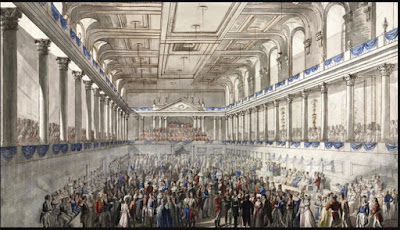The Congress of Vienna was an important political gathering, but there was more to it than politics. As we saw last week, diplomatic progress was slow and most of the negotiating took place in small meetings of representatives of the most important countries. However, almost all the small states whose rulers had been restored to their thrones with Napoleon’s overthrow chose to send people to the Congress. Hundreds of representatives turned up with their entourages, swelling the population of Vienna by more than a third. (August Louis Charles, compte de La Garde-Chambonas writes that “the number of strangers attracted to Vienna by the Congress was estimated at close upon 100,000.”) With Napoleon apparently defeated, all of these people felt they had something to celebrate and it became a matter of pride for the Emperor of Austria to lay on the grandest of entertainments.
Perhaps inevitably, the Congress became as much a grand social occasion as a political summit. Many people believe that Austria owes its reputation as the ballroom dance capital of the world (think Viennese waltzes) to the Congress of Vienna. Talleyrand wrote in November:
The Court of Vienna continues to entertain its noble guests with hospitality, which, considering the state of its finances, must be very onerous to it. Everywhere are to be seen emperors, kings, empresses, queens, hereditary princes, reigning princes, etc, etc; the Court pays everybody’s expenses and the expenditure of each day is estimated at 220,000 paper florins.
The compte de La Garde-Chambonas suggested that the delights offered by Vienna which included “banquets, concerts, shooting parties, masked balls and musical rides” rather took precedence over any actual diplomatic work.
In reality, little or no attention was paid to diplomatic discussions. With the exception of some idlers or journalists … society was engrossed with the pleasures of the fete of the hour, or with preparations for that next day… The sovereigns … foregathered every day for an hour before dinner, and were supposed to discuss the subjects that had occupied the attention of their plenipotentiaries. The carping outside world maintained, however, that politics were the thing least talked of in that august Olympian assembly, and that the announcement of a forthcoming pleasure party more often than not monopolised the conversation.
The festivities were designed to include ordinary people, as well as the monarchs and other dignitaries. In this respect, the most splendid event was the “People’s Fete”. It started with a parade of Austrian veterans of the war. Four thousand had been invited who “afterwards took possession of a number of spacious tents, set apart for their special use.” (Compte de La Garde-Chambonas.) The soldiers had the opportunity to compete in foot races, horse races and archery, professional performers showed off trick riding acrobatics and a display of gymnastics. “Finally an enormous balloon rose in the air…[soaring] majestically above the crowd, waving a number of flags of the various nations whose representatives had foregathered in Vienna.” After the balloon ascent, the 4000 veterans were served a feast at sixteen (presumably very large) tables, while dancers in national dress performed folk dances from their various countries.
The famous portraitist, Isabey (whose picture of delegates to the Congress illustrated last week’s post) had travelled specially to Vienna and was set up in a magnificent studio where many of the delegates and other guests had their portraits painted.
New Year provided an opportunity for the Comtesse Zichy (who had won the heart of the King of Prussia) to give a grand ball for all of the sovereigns, but most lavish entertainment was probably the grand sleighing party thrown in January 1815. The parade of over thirty sleighs was led by “an immense sleigh drawn by six horses and containing an orchestra of kettle drums and trumpets” with another huge sleigh carrying a band dressed in Turkish uniforms and playing “warlike tunes” to bring up the rear. Around a frozen lake the guests paused to watch a display by skaters in “the most elegant costumes of the various countries of Northern Europe”. After yet another ball, the sleighs returned to Vienna by torchlight.
What one participant referred to as “these sovereigns on their holidays” had to be, as the compte de La Garde-Chambonas perceptively wrote, “constantly amused, or at any rate prevented at all cost from being bored.” As 1815 wore on, though, there were signs that the Emperor of Austria was running out of ideas (or the money to pay for them). Delegates began to arrange their own entertainment. The British admiral, Sir Sidney Smith, organised a subscription picnic, with even kings expected to pay for their food – much to the embarrassment of the king of Bavaria, who, like today’s Queen, did not (on this occasion at least) have any money on his person. A waiter stood shaking a large silver bowl in which everybody else’s payments rattled noisily until the king was rescued by the Emperor Alexander who, it turned out, was carrying a full purse.
All too soon the festivities were to end. As word of Napoleon’s return spread, an amateur company was playing Le Calife de Bagdad and Les Rivaux d’eux-memes in Vienna. The compte de La Garde-Chambonas noted that “there was a larger audience than might have been expected.”
It was, however, the final flicker of the expiring lamp; the last feeble sound of the broken instrument. Pleasure took flight. “The Congress is dissolved.”
References
August Louis Charles, compte de La Garde-Chambonas Anecdotal Recollections of the Congress of Vienna
The Correspondence of Prince Talleyrand and King Louis XVIII during the Congress of Vienna published by Harper & Brothers of New York in 1881
Illustration is Redoubt at the Congress of Vienna (1815) by Johann Nepomuk Hoechle


No comments:
Post a Comment